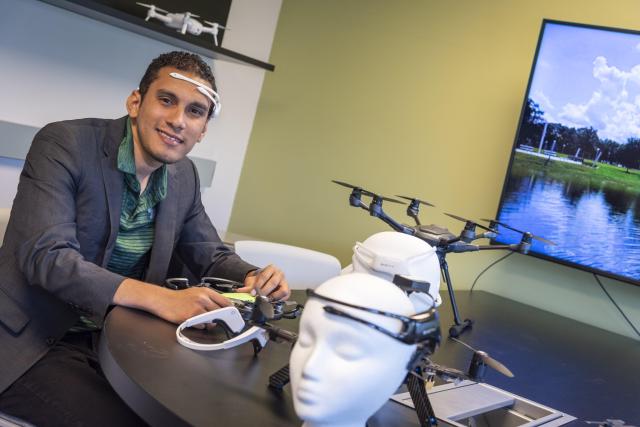Kean Graduate Pioneers Brain-Computer Interface Projects, Including Hands-Free Painting

It may sound like science fiction, but Kean University alumnus Marvin Andujar, Ph.D., has helped people paint pictures and fly drones hands-free, using only their brains.
The 2012 computer science and math graduate founded the brain-computer interface research program at the University of South Florida, where he’s been an assistant professor of computer science and engineering since 2017.
“This interdisciplinary field consists of areas including computer science, psychology and neuroscience,” Andujar said. “I like to work on things that don't exist and may seem weird but can have an impact on society and people’s lives.”
In his Neuro-Machine Interaction Lab, Andujar applies the principles of human-centered computing and generates strategies designed to noninvasively improve people’s lives and their ability to focus on daily activities.
Participants in his studies create art by mentally selecting shapes and colors from a screen. “Brain painting” is enabled by technology that reads the brain’s electrical signals. Its goals are to improve concentration, retention and mental health, including for people with ADHD. Brain-controlled technologies can also help people who have paralysis, as only their brain data input is needed.
He started his brain-computer interface research at the University of Florida, working with a peer to hold the world’s first brain drone race before graduating in 2017 with a Ph.D. in human-centered computing.
Professor and doctoral advisor Juan E. Gilbert, Ph.D., who anticipated that Andujar “was going to be a great innovator,” called the 2016 drone race “an amazing accomplishment that demonstrated the efficacy of brain-computer interface.”
That same year, Andujar won $300,000 of support for his work while interning at Intel, after pitching the brain drone interface project to leaders there who asked for an idea to “blow our socks off,” as Andujar recalls.
A teenager when his family moved to the United States from the Dominican Republic in 2004, Andujar first started contemplating career options at Perth Amboy High School, where he was passionate about technology and the brain. He became the first in his family to graduate high school.
“Because I was the oldest, my mother wanted to make sure I served as an example to my siblings by getting a college degree and doing something with it,” he said.
Andujar chose Kean for the scholarships it offered, and dropped transfer plans at one point in his education when Kean granted him additional enrichment opportunities through scholarship programs for students from underserved populations.
In 2012, Andujar earned a bachelor of science in computer science and a bachelor of arts in mathematical sciences from Kean.
Kean Professor Patricia Morreale, Ph.D., chair of the Department of Computer Science and Technology, remembers Andujar as “a very engaged student” and “a very collaborative individual” who embraced the opportunities Kean offered.
“I've been particularly impressed with how mindful Marvin is, moving the research agenda of his Neuro-Machine Interaction Lab forward while including undergraduates in his research, conscious of developing the next generation of brain interface researchers,” Morreale said. “No one drops out of Marvin's orbit – the impact and reach of his work is continuing to expand, even as his research agenda grows.”
Andujar has studied both non-immersive and virtual-reality brain painting as a means of increasing attention and retention, and recently completed quantitative and qualitative data analyses with promising results. Now, he’s analyzing the data in preparation for journal publication.
He is also helping a Ph.D. candidate test a mobile device that promotes relaxation through white-noise meditation and then tracks and supports the user’s attentiveness to reading, studies or work. Outside the lab, he helps media startups gauge their success by measuring the emotional reactions of customers to music or videos.
Andujar said he loves his job’s variety, including meeting some of his field’s top professionals, and said through his work, he developed a photographic memory after years of controlling technology with his brain.
Andujar also advises his students to persevere.
“As researchers, 99% of the time we're not going to see a good result,” he said. “So, block out people saying you can’t do something or that it’s too unorthodox. Get advice from mentors who really care about you, and always be persistent.”